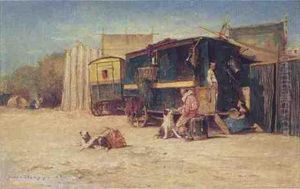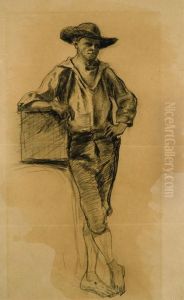Jules Edouard Magy Paintings
Jules Edouard Magy was a Belgian artist known for his contributions to painting and graphic arts in the late 19th and early 20th centuries. Born in 1860 in Belgium, Magy's career spanned a period of significant change in the European art world, as artists began to move away from traditional academic styles and explore new forms of expression.
Magy received his artistic training at the Royal Academy of Fine Arts in Antwerp, which was a leading institution for art education in Belgium. There, he honed his skills in painting and printmaking, disciplines that he would continue to develop throughout his career. He was particularly influenced by the works of the old masters, as well as by the contemporary movements of Impressionism and Symbolism that were gaining popularity at the time.
Throughout his career, Magy exhibited his work at various salons and art exhibitions, gaining recognition for his unique style. His paintings often featured evocative landscapes, still lifes, and portraits, marked by a delicate use of color and light. He was also known for his etchings and lithographs, which showcased his technical prowess and attention to detail.
Beyond his artistic practice, Magy was involved in the broader cultural landscape of Belgium. He was a member of several artistic societies and contributed to the dialogue on art in his community. Despite this, Magy never achieved the same level of fame as some of his contemporaries, and his work remained relatively unknown outside of Belgium.
Jules Edouard Magy's legacy is preserved through his artworks, which can be found in private collections and museums in Belgium. His dedication to his craft and his exploration of various artistic styles reflect the dynamic nature of the art world at the turn of the century. Magy passed away in 1932, leaving behind a body of work that continues to be appreciated by art historians and enthusiasts for its contribution to the Belgian art scene of his time.

